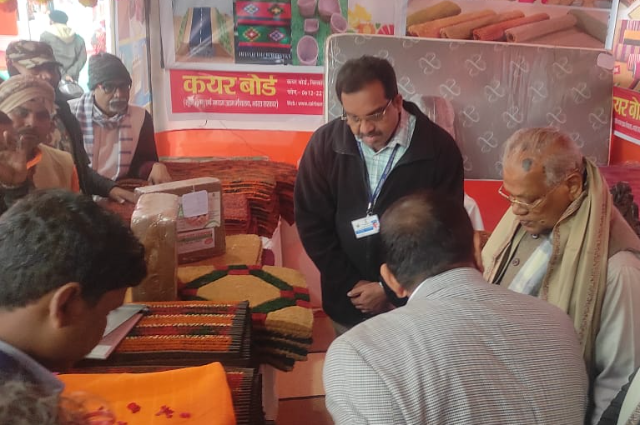The Ministry of Micro, Small, and Medium Enterprises (MSME) has established the Khadi India Pavilion at the Mahakumbh 2025 event. According to a press release from the Ministry of Culture, this initiative invites visitors to explore an exhibition that celebrates India's continuing cultural heritage. The exhibition highlights the country's dedication to promoting sustainable, locally-made products, reflecting a deep-rooted commitment to environmentally friendly and community-driven enterprises.
Showcasing India’s Rich Craftsmanship
The Khadi India Pavilion is a testament to India's rich tradition in local crafts, textiles, and indigenous industries with a special emphasis on Khadi. Khadi, a hand-spun and hand-woven fabric, holds historical significance in India’s struggle for independence and continues to be a symbol of self-reliance and sustainability.
A Grand Display of Khadi and Village Industries
The exhibition which takes place in Prayagraj, will run until February 26. It features an impressive array of 152 stalls, where 98 are dedicated to showcasing various Khadi products. The remaining 54 stalls are devoted to displaying products from village industries. This diverse collection highlights the vast range of craftsmanship across India with contributions from over 20 states.
Celebrating Local Craft and Sustainability
This exhibition not only provides a platform for artisans to display their work but also reinforces the importance of sustainable practices. By focusing on locally-made products, the Khadi India Pavilion supports small industries and promotes eco-friendly alternatives, thus helping to preserve India’s cultural and environmental legacy.
The Khadi India Pavilion at Mahakumbh 2025 is a vibrant celebration of India’s rich heritage in traditional crafts and a commitment to sustainable development. Visitors are encouraged to participate in this cultural showcase and experience the diverse artistry that defines India.
The Pavilion: A Testament to Tradition, Sustainability, and Craftsmanship
The pavilion at the Khadi Utsav exhibition serves as a powerful symbol of how tradition, sustainability, and craftsmanship can seamlessly blend to preserve cultural values and foster national unity. Positioned within the historic and spiritual context of the Maha Kumbh Mela, the pavilion underscores India's dedication to promoting local industries and sustainable practices.
Khadi's Transformative Journey
A key highlight of the exhibition is the vibrant display that showcases India's enduring love for Khadi. This traditional fabric's transformative journey, especially under Prime Minister Narendra Modi's 'Vocal for Local' initiative, takes centre stage. The initiative encourages the nation to embrace local products and industries with Khadi being a shining example of this movement.
The Khadi Utsav exhibition in Prayagraj, organized by the Ministry of Micro, Small and Medium Enterprises (MSME) has attracted a significant number of visitors. This growing interest highlights the public's appreciation for local craftsmanship and heritage. The event not only celebrates the art of making Khadi but also serves as a reminder of the rich cultural traditions that have been passed down through generations.
A Tribute to Mahatma Gandhi and Self-Reliance
The exhibition site features a tribute to Mahatma Gandhi, the father of the Khadi movement further emphasizing the 'self-reliant' theme of Atmanirbhar Bharat. This theme resonates with the broader goal of making India self-sufficient by boosting local industries and sustainable practices as promoted through the Khadi Utsav - 2025.
With an expected attendance of around 40-45 crore (400-450 million) pilgrims, the Maha Kumbh Mela stands as a monumental platform to showcase the success stories of various initiatives. The event deeply rooted in spiritual and cultural significance, also serves as an opportunity to display the nation's commitment to supporting local industries by promotion of sustainability and preserving cultural heritage.
This aims to provide a comprehensive view of how Khadi Utsav not only celebrates a traditional fabric but also symbolizes a broader movement towards self-reliance and sustainability in India.
The Spiritual Significance of Prayag: A Deep Dive into the Holiest Pilgrimage
Prayag, presently known as Allahabad holds an unparalleled spiritual significance for Hindus. River meetings are traditionally seen as sacred, but the Sangam at Prayag is considered the most holy. This is where three rivers, the Ganga, Yamuna, and the mythical Saraswati, converge into one, elevating its spiritual status to the highest echelon.
The Legend of the Sacred Drops
According to ancient tales, Lord Vishnu was transporting a pot of amrit, the nectar of immortality when a conflict ensued, causing four drops of this divine liquid to spill onto Earth. These drops landed at four holy places: Prayag, Haridwar, Nasik, and Ujjain. Each of these locations known as Tirthas, became sanctuaries where devotees could seek salvation. Among these, Prayag is honoured as Tirtharaj, the 'King of Tirthas,' and it hosts the Kumbh Mela every twelve years, the most revered of all gatherings.
The Grandeur of the Maha Kumbh Mela
The Maha Kumbh Mela held in Prayag, is the largest religious worshipers in India, drawing millions of pilgrims. This grand fair lasting over a month, transforms Prayag into an extensive tented city. The government, local authorities, and police work meticulously to manage the influx, ensuring adequate infrastructure, security, and civic amenities.
A Gathering of Ascetics and Devotees
What makes the Kumbh Mela especially remarkable is the congregation of a vast array of religious ascetics—sadhus and mahants—who travel from secluded retreats in forests, mountains and caves. The astrologers pinpoint an auspicious moment called the Kumbhayog, for the sacred dip. The Naga Sadhus, or Naga Babas, are the first to immerse themselves in the waters. Clad only in ash and with hair in long dreadlocks, they march with the zeal of a charging army by reflecting their role as the spiritual protectors of the faith.
Looking Ahead to the Next Maha Kumbh Mela
The most recent Maha Kumb,h Mela took place in 2013, and preparations are already underway for the next grand event in 2025. This gathering not only epitomizes religious dedication but also showcases the seamless integration of tradition and modernity by making it a spectacle of both faith and organization.
. . .
References:

